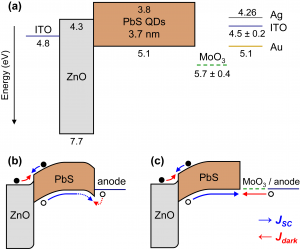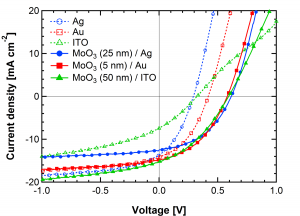Improved Current Extraction from Colloidal Quantum Dot Photovoltaics Using Metal Oxide Transport Layers
Solar cells based on lead sulfide colloidal quantum dots (PbS QDs) have demonstrated recent improvements in both efficiency and stability [1] . With bandgaps tunable from 0.5 eV to 1.7 eV, PbS QDs offer infrared spectral responsivity surpassing that of organic materials and provide a potentially facile route to multijunction architectures. Because of their high elemental abundance and amenability to ambient-atmosphere solution-phase deposition and operation, PbS QDs represent a promising candidate for expansion into large-area production if further efficiency enhancements may be realized. Recent studies on ZnO/PbS np-heterojunction solar cells have identified the presence of a reverse-bias Schottky barrier at the top PbS/anode contact as a primary loss mechanism in PbS QD photovoltaics (Figure 1b) [2] . This barrier inhibits the extraction of photogenerated holes from the p-type PbS active layer, leading to reductions in the open circuit voltage (VOC), fill factor (FF), and efficiency.
Our research demonstrates that this Schottky barrier may be attenuated through the incorporation of a molybdenum oxide (MoO3) interlayer between the PbS QDs and the top-contacted anode (Figure 1c) [3] . The high-work-function MoO3 layer pins the Fermi level of the top contact, resulting in a high VOC (0.59 ± 0.01 V) regardless of the anode work function. Corresponding increases in short-circuit current (JSC) and FF enable 1.5-fold, 2.3-fold, and 4.5-fold enhancements in photovoltaic device efficiency for Au, Ag, and ITO anodes, respectively (Figure 2), and result in a power conversion efficiency of 3.5 ± 0.4 % for a device employing a gold anode. The effective decoupling of device performance from the identity of the anode material allows for greater flexibility in the design of the photovoltaic device architecture and, by enabling the use of transparent electrodes without loss in VOC, represents a step toward demonstration of stacked multijunction quantum dot photovoltaics.
- Figure 1: (a) Flat-band energy alignment of the ZnO/PbS heterojunction photovoltaic device. Illumination under normal operation is incident from the ZnO side. (b) Proposed band-bending in the MoO3-free device, showing the depleted np-heterojunction at the ZnO/PbS interface and a hole-current-limiting Schottky contact at the PbS/anode interface. (c) The removal of the Schottky barrier following the insertion of MoO3 between PbS and the anode material.
- Figure 2: J-V characteristics under illumination of ITO/ZnO/PbS/MoO3/anode devices with varying thicknesses of MoO3, where the anode is Ag (blue circles), Au (red squares), or ITO (green triangles). The roll-over in light current observed at +0.5 V for the device employing an ITO anode without MoO3 is ascribed to the presence of a Schottky junction at the anode contact. The addition of MoO3 alleviates this roll-over and simultaneously increases the JSC, VOC, FF, and efficiency.
- J. Tang and E. H. Sargent, “Infrared colloidal quantum dots for photovoltaics: Fundamentals and recent progress,” Advanced Materials, vol. 23, pp. 12-29, Sep. 2010. [↩]
- J. Gao, J. M. Luther, O. E. Semonin, R. J. Ellingson, A. J. Nozik, and M. C. Beard, “Quantum dot size dependent J-V characteristics in heterojunction ZnO/PbS quantum dot solar cells,” Nano Letters, vol. 11, pp. 1002-1008, Feb. 2011. [↩]
- P. R. Brown, R. R. Lunt, N. Zhao, T. P. Osedach, D. D. Wanger, L.-Y. Chang, M. G. Bawendi, and V. Bulovic, “Improved current extraction from ZnO/PbS quantum dot heterojunction photovoltaics using a MoO3 interfacial layer,” Nano Letters, vol. 11, pp. 2955-2961, June 2011. [↩]

